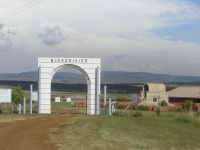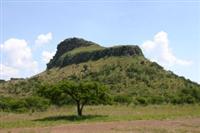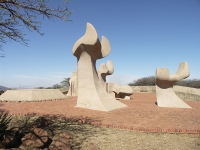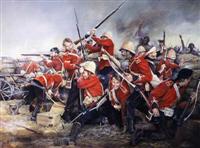
Following a long period of conflict and mistrust, including the treacherous murder of Piet Retief and his companions at the hands of the Zulu chief Dingaan, the Voortrekkers, led by Andries Pretorius, prepared for battle against the Zulu kingdom on the banks of the Ncome River on 16 December 1838. The 460 Voortrekkers formed an impenetrable laager, a defensive camp encircled with their ox-wagons, and fought the 15,000-strong impi attack until the Zulus finally retreated, leaving thousands dead and the river red with blood. The violent encounter became known as the Battle of Blood River. About 3,000 Zulu warriors are thought to have died in the battle but the Voortrekkers sustained only injuries. The Blood River/Ncome Heritage Site commemorates this significant battle with monuments and museums to both the Voortrekkers and the Zulus on both sides of the river. This gives the visitor a more complete perspective of events. On the east side is the Ncome Monument and Museum Complex, dedicated to the fallen Zulu warriors, while the Blood River Monument and Museum is located on the west bank and features a life-size replica of the Boer wagon laager. The Ncome Museum building was designed in the shape of buffalo horns, recalling the battle formation in which the Zulu army attacked. It is definitely advisable to visit both museums.
Address : The site is 30 miles (48km) east of Dundee, off the R33
Website : www.ncomemuseum.co.za

The battle at Isandlwana Hill on 22 January 1879 stunned the British Empire in what was to be the worst defeat in their imperial history. The news that an entire battalion of British troops had been wiped out by a 'native' army was unbelievable. Led by King Cetshwayo, the Zulu Kingdom had refused to submit to British rule and had been gaining strength. Consequently, it was perceived as a threat to British colonists. British troops were ordered to invade Zululand, but grossly underestimated the Zulu warriors. The surprise attack on the Isandlwana Hill British camp left hundreds dead. Isandlwana was the first major encounter of the Anglo-Zulu War. A force of about 20,000 Zulu warriors attacked a portion of the main British column, consisting of about 2,000 soldiers. British fatalities numbered about 1,300 and the Zulus sustained almost as many fatalities, but their far greater numbers gave them a decisive victory. The far superior weapons technology of the British should have enabled them to withstand the attack but they were very poorly deployed.Today, the battlefield is dotted with memorials, and mounds of white stones that mark the British mass graves. The beauty of the place belies the horror it once witnessed.
Address : The battlefield is 50 miles (80km) southeast of Dundee off the R68

During the South African War, Ladysmith was besieged for 118 days between 2 November 1899 and 28 February 1900. Thousands died, either during battle or from disease and the lack of food and water. 21,000 Boers advanced into Natal from all sides when war was declared between the Boer republics and Britain. After two notable battles, the Boer forces surrounded the garrison town of Ladysmith, where the British commander and his core force were deployed. The siege was eventually broken by the British when a relief force entered Ladysmith - a force which included a young Churchill. But as with many battles in the war, it was a more a voluntary dispersal than a defeat, with the Boers choosing to fight another day rather than face British reinforcements. One touching story from this tragic and protracted siege is the tale of how the Boers sent a single unexploded shell into Ladysmith on Christmas day. It contained a Christmas pudding and a note wishing the British troops compliments of the season.The museum is considered one of the best Anglo-Boer War museums in the country. Its collection of artefacts, documents, firearms, and uniforms, as well as its series of excellent photographs tell a vivid story of battles between the Boer and British forces.
Address : Murchison Street, Ladysmith
Website : www.battlefieldsroute.co.za/place/ladysmith-siege-museum

Fought on the same day as the nearby battle at Isandlwana Hill, the Battle of Rorke's Drift is remembered as one of the most famous sieges of the Anglo-Zulu War. Survivors from Isandlwana fled to the Swedish mission station that was used as a British field hospital and storehouse, and sounded the alarm. Inside, the 139 men, many of them ill or wounded, barricaded themselves in and prepared for the onslaught of 4,000 Zulu warriors. The Battle Museum dramatically tells the tale of the 'Heroic Hundred' who desperately defended the station for 12 hours, until the Zulus finally retreated with a heavy loss of life. Seventeen British soldiers and about 500 Zulu attackers were killed in the siege. Eleven Victoria Crosses were awarded to the defenders, not the most ever given at any battle in British history, as is often claimed, but a prestigious honour nonetheless, and the most ever awarded to one regiment in a single action.It is generally thought that although the courage of the defenders warranted recognition, the awards were also made to distract public opinion from the disastrous British defeat at Isandlwana. Interestingly, just before the Zulus arrived, a number of defenders fled Rorke's Drift and those remaining were so angry at the desertion that they shot after their own men, killing a corporal.
Address : The site is 26 miles (42km) from Dundee, off the R68

Travel Guide powered by Word Travels, copyright © 2023 Globe Media Ltd. By its very nature information in this travel guide is subject to change at short notice and travellers are urged to verify information on which they're relying with the relevant authorities. Neither Globe Media Ltd nor Travel Vogue can accept any responsibility for any loss or inconvenience to any person as a result of information contained above.